![]() Rajiv Gandhi Trust's Land Grab is an open-and-shut case, but Govt. seems reluctant to use the Ammo
Rajiv Gandhi Trust's Land Grab is an open-and-shut case, but Govt. seems reluctant to use the AmmoMarch 2, 2017
Shalini Singh is a senior award-winning investigative journalist.
![Rajiv Gandhi Trust’s Land Grab Is An Open-And-Shut Case, But Government Seems Reluctant To Use The Ammo]() If Congress vice-president Rahul Gandhi is guilty of crying wolf over instances of alleged "personal corruption" by Prime Minister Narendra Modi and dilly-dallying over producing "concrete evidence", the latter is perhaps guilty of the reverse: sitting on substantial ammunition already available against the Gandhi family.
If Congress vice-president Rahul Gandhi is guilty of crying wolf over instances of alleged "personal corruption" by Prime Minister Narendra Modi and dilly-dallying over producing "concrete evidence", the latter is perhaps guilty of the reverse: sitting on substantial ammunition already available against the Gandhi family.A case in point is the allotment of prime panchayat land to the Rajiv Gandhi Charitable Trust (RGCT) in Haryana during the chief ministership of Congressman Bhupinder Singh Hooda. The five-acre prime property on the Gurgaon-Faridabad highway – a real estate gold mine – was allotted to the trust for constructing an eye hospital for the poor.
The RGCT is headed by Congress president Sonia Gandhi. Manoj Muttu is the trustee/administrator, while the other trustees include Rahul Gandhi, Priyanka Gandhi Vadra, Capt Satish Sharma, Murli Deora (deceased) and Kishori Lal Sharma.
Strikingly, the plot was part of panchayat land notified by the government for acquisition. It was transferred to the trust by stretching, bending and openly violating rules leading to adverse comments from the High Court, the Principal Accountant General (Audit) and the Comptroller and Auditor General of India (CAG).
The RGCT case mirrors the land grab history associated with the Associated Journals Ltd (AJL) – now better known as the
National Herald case – against Sonia Gandhi, Rahul Gandhi and others, as also the alleged irregularities in the land deals of Robert Vadra which were investigated by the Justice Dhingra Commission.
In July last year, on the eve of the submission of the inquiry report by Justice Dhingra, Congressmen had wagged their fingers over alleged out-of-turn benevolence in the grant of panchayat land for a Gurgaon-based charitable trust headed by the retired judge. That turned out to be a fairly frivolous charge deliberately made to undermine the credibility of the judge. But that exact charge – gifting away panchayat land – is now staring right back at the Congress party with clear evidence that the Hooda government unlawfully tweaked policies to make an allotment of five acres of prime panchayat land to RGCT.
The Dhingra Commission was set up to examine Hooda’s role in the illegal grant of licences to hundreds of private companies and trusts, including to companies promoted by
Robert Vadra (Skylight Hospitality) and real estate major DLF. The report, which was submitted in August last year, has not been made public by the Haryana government so far due to a court stay obtained by a resourceful Hooda.
An unrepentant Hooda had mocked the ruling state government in the Vidhan Sabha at the very beginning of its tenure, challenging the Bharatiya Janata Party to prove charges against him.
Now, let’s examine the RGCT file history. An examination of the various twists and turns recorded in government files reveals a pattern of wilful violation of laws aimed at delivering undue pecuniary advantage to an individual/organisation entirely reminiscent of the National Herald case, where the Congress party helped finance the takeover of properties worth several thousand crores, owned by Associated Journals, by a private trust in which Sonia Gandhi and Rahul Gandhi were the main shareholders. Among other things, Associated Journals owns Herald House in Delhi’s Bahadur Shah Zafar Marg, a prime location.
As in the AJL case, the bait for getting allotment of prime land was noble: setting up a 300-bed, state-of-the-art eye hospital for the poor. The result, after a thorough mauling of rules, was the allotment of land on the Gurgaon-Faridabad highway, one of the costliest real estate belts in the country. The eye hospital is yet to see the light of day and the serial violations of rules mean any government can revoke the allocation.
Here is a quick sketch of the six-and-a-half-year journey of the RGCT file that tells us that rules are only for those who want to follow them. For the others, there are other ways and means to profit unlawfully:
9 May 2008: Manoj Muttu, trustee/administrator, RGCT, writes to the then sarpanch of Ullahawas village in Gurgaon district, requesting the gram panchayat to transfer/allocate six acres of land for a 300-bed, "state-of-the-art” eye hospital to cater to the needs of Haryana.
27 May 2008: The Ullahawas Gram Panchayat meets, passes a resolution to allow the sale of the land at market rates to the RGCT and forwards the resolution to the Deputy Commissioner (DC), Gurgaon, for approval.
However, the DC does not recommend its approval to the Haryana government, for two reasons:
(1) Panchayat land cannot be alienated by way of gift or sale. This is as per the Haryana government's instructions issued on 3 March 2008, and an earlier amendment of the Punjab Village Common Lands (Regulation) Rules, 1964, on 3 January 2008, done precisely to prevent such alienation of panchayat land.
(2) The land was already under lease to a private person. The gram panchayat had leased the land on 11 June 2004, for five years, for a lumpsum amount of Rs 15,200. Sale of the land before the expiry of the lease period on 10 June 2009 could have led to litigation.
2 June 2009: A week before the expiry of the lease, the government notifies roughly 1,417 acres, including the five-acre Ullahawas Panchayat land, under Section 4 of the Land Acquisition Act, signalling its intention to acquire the land for a number of HUDA (Haryana Urban Development Authority) sectors.
10 July 2009: The RGCT approaches the panchayat again, but this time, instead of offering to purchase the land, requested that it be leased for the maximum permissible period of 33 years.
20 July 2009: The Ullahawas Gram Panchayat passes a resolution with three-fourths majority to lease the land – according to the terms cleared by the government – to RGCT for 33 years or more. The terms specify that below poverty line (BPL) families of the village would get free treatment, residents would get concessional treatment as well as priority in recruitment to Class IV jobs in the hospital. The resolution was forwarded to the Deputy Commissioner, Gurgaon, for approval.
31 July 2009: Just 11 days after the panchayat resolution, the Deputy Commissioner, Rajendra Kataria, clears the proposal on the ground that the land was uneven and not being used and, therefore, fell under Category III of government instructions dated 3 March, 2008, issued under Rule 6 (5) of the Punjab Village Common Lands (Regulation) Rules 1964, which permits such land to be leased. The land is described in the revenue record as banjar-qadim (barren land). He further recommends a lease amount of 5 per cent of the collector rates, which was Rs 60 lakh per acre at that time, or a total of Rs 3 lakh per annum.
13 August 2009: Chief Minister Hooda, who also holds charge of the Development and Panchayat Ministry, approves the DC’s proposal to lease the land to RGCT after adding that, "the Urban Estates Department be advised to exclude the land from acquisition."
21 August 2009: This proposal is cleared by the Haryana Cabinet, but after adding two additional sweeteners: A lower lease value of just Rs 5,000 annually and only 5 per cent of hospital beds to be reserved for the nominees of the state government at a concessional rate.
The order is signed by Urvashi Gulati, the then financial commissioner and principal secretary, Development and Panchayat Department, and issued the very same day.
However, RGCT, after getting everything served up on a platter, now refuses to accept the concessional rate of lease and insists on doing everything as per the existing policy of the government.
11 November 2009: RGCT tells Ullahawas Gram Panchayat that it does not want land at concessional rates but is willing to pay the lease money at par with the existing rates prescribed by the government.
23 November 2009: The panchayat passes a resolution to this effect and approaches the DC the next day for approval to increase the lease amount equal to 5 per cent of the collector rate of the land – the prescribed annual rate of Rs 3 lakh per acre.
4 December 2009: The Haryana Cabinet dutifully approves the changed lease rates and states that the gram panchayat would get Rs 15 lakh annually for its five acres of land, to be increased by 5 per cent every five years.
8 January 2010: The lease deed is executed between the panchayat and RGCT, with a rider that the land would be put to the permitted use by RGCT within two years from the date of commencement of the lease period, and that in case of breach of any of the conditions by the lessee, the lease shall automatically be deemed to be cancelled/revoked.
20 October 2010: The trust applies for change of land use (CLU) permission with the District Town Planner (E) Gurgaon.
The very same day, the policy of the government is changed to make a 33-year lease a valid title document for the purpose of CLU permission.
24 November 2010: After the requisite policy change, the file is sent to the District Town Planner (E), Gurgaon, approved and forwarded again on the same day by the State Town Planner to Director, Town and Country Planning, Haryana.
25 November 2010: The file is received in the office of Director, Town and Country Planning, Haryana.
On the same day, Assistant Town Planner, Satish Kumar Arora (ATP, SKA), notes: “There is no policy to grant CLU permission for land notified for acquisition. Hence, before submitted case for approval, the applicant/society may be requested to submit the revenue documents in the name of applicant/society having clear title of land”.
His boss, Devendra Nimokar, District Town Planner (DTP), Headquarters, endorses this stand: “....as per Release Policy dated 26/10/2007, the land cannot be released while granting the CLU permission, therefore, before considering the case for CLU permission, the applicant/trust may be advised to get the land released from competent authority/department and then apply to this office for seeking CLU permission".
However, T C Gupta, director, Town and Country Planning (TCP), the overall chief, overrules both of them and orders that “case fulfils parameters for grant of CLU… However, since the land had been notified for acquisition under Section 6 CLU cannot be granted till the time land is released by the government. Since the land belongs to gram panchayat and has been given on lease to the applicant, which is a charitable trust, it will be in public interest to release this land. Hence, case is submitted for ‘in principle’ approval of the government to grant CLU subject to the condition that the land shall be released by the government. Case for release of land shall be submitted on the file of Urban Estates Department separately”.
1 December 2010: The file is approved by Chief Minister B S Hooda.
6 December 2010: PS, TCP, endorses a copy of the release order to RGCT. On the same day, a letter of intent (LoI) is issued to RGCT on the ground that “the government has already given an ‘in principle’ approval for grant of CLU permission”.
5 January 2011: LoI lapses since RGCT fails to complete mandated formalities within one month of its issuance.
11 March 2011: RGCT submits a letter stating its compliance to the terms of the LoI. Compliance is rejected, since it is three months late, and RGCT is directed to apply afresh for the CLU-I application along with scrutiny fee.
25 March 2011: Once again, deviating from the rule book, T C Gupta orders that “applicant may be advised to deposit scrutiny fee again and then permission shall be issued”. CLU permission along with zoning plan is issued to RGCT.
As per law, after the expiry of the LoI, it is mandatory to submit a fresh CLU application along with the scrutiny fee.
5 November 2011: RGCT fails to submit its building plans within the stipulated period of six months.
24 April 2012: The office of the Principal Accountant General (PAG), Haryana, writes a letter alleging irregular release of land.
9 May 2012: The PAG’s letter is forwarded to director, Urban Estates.
12 May 2012: RGCT submits an application for condonation of delay of six months, and seeks an extension of the time for the construction of the proposed hospital. After grant of CLU, the applicant is required to submit its building plans and begin construction within six months.
14 May 2012: RGCT’s application is approved “subject to the condition that the trust shall complete the building within validity period of CLU permission and will apply for occupation certificate within said period”.
16 May 2012: This condition is modified vide memo no. G-2444-JE (S)-2012/3412 which reads: “However, if the building is not completed upto 05.05.2013, then extension for one year may be considered as per rules subject to payment of 10 per cent of conversion charges”.
25 March 2013: RGCT applies for renewal of CLU permission. An extension of one year of CLU permission is granted, subject to the condition that “the applicant be directed to submit the building plan within three months on 26/04/2013”.
25 October 2013: RGCT’s building plans are approved but construction work at site is yet to start.
27 January 2014: RGCT seeks another extension of one year. It said that because of the “involvement of lot a of specialised services, project could not be completed”.
30 June 2014: Assistant Town Planner, HQ, recommends that “extension of a further one year up to 5/5/2015 may be considered with the condition that applicant will obtain occupation certificate within the validity period of CLU permission.”
17 July 2014: A further extension of one year is granted “subject to the condition that the trust shall complete the building and will apply for occupation certificate within validity period of Change of Land Use permission”.
11 August 2014: RGCT, once again, nine months prematurely, submits a request for extension of time period for CLU permission (which was going to expire on 5 May 2015 just before the notification of elections to Haryana assembly).
3 September 2014: Just before the enforcement of the election code of conduct, S S Dhillon, private secretary to the chief minister, issues orders that "CM has seen. He has observed that the applicant has already got building plan approved for starting the construction. He has ordered the applicant will be given one year extension after 5.5.2015, in case the applicant is not able to complete the construction within stipulated period as stated….”
(The last two orders are significant. They are like an insurance policy a government fearful of defeat in the upcoming elections was taking out on behalf of RGCT. Both the permissions – for CLU and building plans – had life in them till 5 May, 2015. But if they had run their course, there was no guarantee that in May 2015 a friendly government would be in the saddle to help RGCT with another extension. So, a full eight months before the deadline, the incumbent government assumed that the trust would not be able to complete the formalities and granted a further one-year extension).
5 May 2016: True to style, before the expiry of its new deadline for CLU permission, RGCT applies for an occupation certificate.
30 December 2016: DTP, Enforcement, Gurgaon, submits its report to Senior Town Planner (STP), Gurgaon, submitting that the building is not ready for occupation so certificate cannot be issued.
3 January 2017: RGCT's application for occupation certificate is rejected by STP Gurgaon and submitted to Director, Town and Country Planning, Chandigarh with two significant recommendations:
That construction is no longer permissible on account of rejection of occupation certificate, and since the lease deed carried a clause that in case of failure to put the land to permitted use within two years the lease should be automatically cancelled/revoked.
At present, the file is with the chief minister’s office awaiting his orders.
The Congress will probably claim vendetta, but these charges are untenable and even courts have taken note of violations.
The High Court – in its judgment of 17 August 2016 – in a matter relating to 1,400 acres of land, which includes the RGCT land – has directed “the Advocate General, Haryana, to have instructions whether the state government is ready and willing to refer these cases for deeper probe to CBI”.
This direction comes after this observation: “What it appears prima facie from the record is that meanwhile a group of private builders entered the field and allured the desperate owners to enter into agreements to sell/collaboration agreements and procured general power of attorneys from such land owners. Thereafter, these builders-cum-developers in prima facie collusion and connivance with the state machinery, got the land released from the acquisition process. It is for this reason that the proposal to acquire 1,400 acres land stood reduced the requirement of so called “Public Purpose” to 87 acres only.”
Additionally, some recent Supreme Court judgments in the
Uddar Gaggan and other land-related matters, have also ruled that release of land after notification of Section 4 (whereby the government declares its intent to acquire land for 'public purpose’) and giving licence on such land, is unlawful and violative of the policies of the state government itself. The state policy mandates that no change of land use (CLU) application can be entertained in case of transfer of such rights after a notification of Section 4.
RGCT is yet another case of blatant violations of all such stipulations during the Hooda regime.
PAG, CAG highlight violations
The Principal Accountant General (Audit), Haryana, in its report on the Social Sector dated 24 April 2012, has expressly alleged “Undue favour in (the) release of land to a trust”, stating that “As per policy of state government… there was no provision to release the land and grant change of land use permission for the land notified under Section 4 for acquisition on which the applicant had no clear title of land.”
“The government changed the relevant rules on 8 November 2010, for treating trusts having panchayat land on lease basis as owners for the purpose of grant of CLU after the receipt of application of the trust on 20 October 2010. The application of the trust as on 20 October 2010 was not valid”.
The report goes on to observe that: “The acceptance of change of land use (by the CM on 1 December 2010) was not in order as the land had already been notified for acquisition and the trust was not having clear title before the issue of notification under Section 4.”
The PAG Audit report further highlights this: “The release of land was also not in order as it was done by deviating from the policy framed by the state government since the trust was not in existence at the time of issuance of notification on 2 June 2009 under Section 4 of the Land Acquisition Act, 1894.”
It also asks whether the trust has paid HUDA External Development Charges.
The March 2012-13 report of the Comptroller and Auditor General of India (CAG) on Social, General and Economic Sectors endorsed the findings of the PAG, pointing out that “Release of land (is) in violation of provisions of the Act”.
“The Punjab Scheduled Roads and Controlled Areas Restriction of Unregulated Development Rules, 1965, relating to CLU was modified by issuing a notification (8 November 2010) making the lessee of panchayat land eligible for applying for CLU. The proposal for the grant of CLU to the trust was accepted on 1 December 2010, subject to the condition that the land would be released by the government. The proposal about release of land was submitted on 3 December 2010 and was granted on the same day.
"Instructions issued (March 2008) by the state government inter alia laid down that the lessee shall put the leased land to the permitted use within two years from the date of commencement of lease period. Audit observed (December 2012) that even after two years, work regarding construction of the eye hospital had not been started by the trust thereby defeating the very purpose for which CLU was granted and land leased.
“The PS, TCPD stated during exit conference that the land was released in favour of the gram panchayat (GP) which was the owner of the land, but CLU had been granted in favour of the trust as per policy of the department. He further stated that the grant of CLU had been processed as per policy of 8 November 2010 which permitted CLU to the lease holders of GP’s land. He further stated that the government had powers to consider release of land under Section 48 of the Act where award of the same had not been announced and, therefore, the release of land had been done in accordance with the policy dated 26 October 2007.
"The contention of the PS was not in order as the GP (gram panchayat) had leased the land after issue of notification under Section 4 which was against the provisions of the Act as the owners cannot create any encumbrance on the land after the issue of notification under Section 4. Further, GP which was the owner of the land, had not approached the government for the release of land at any stage; the government changed the relevant rules on 8 November 2010 whereas the application of the trust was made on 20 October 2010; the department granted CLU for establishing an eye hospital by the trust in violation of its development plan as the area had been demarcated as a residential area; the government released land in contravention to the land release policy as no objection was filed by the GP under section 5-A and before leasing its land, the GP had not given proper publicity/advertisement for calling applications from interested parties, as required under Rule 10 of the Punjab Village Common Lands (Regulation) Rules, 1964, to participate in the competition for ensuring transparency in the bidding process.”
And guess what Rahul Gandhi was up to just then?
Interestingly, even in August, 2011, while the Congress government in Haryana was unfolding this elaborate plan to hand over prime panchayat land to the Rajiv Gandhi Charitable Trust, the party's general secretary (now vice-president)
Rahul Gandhi was making high-voltage forays into Bhatta Parsaul in Uttar Pradesh to express solidarity with farmers protesting against land acquisition there.
It seems the NDA government, despite having solid ammo against Rahul Gandhi, is pussy-footing around the issue. One wonders why.
https://swarajyamag.com/politics/rajiv-gandhi-trusts-land-grab-is-an-open-and-shut-case-but-government-seems-reluctant-to-use-the-ammo The move comes in the backdrop of allegations that kickbacks from this project have been paid to the Congress high command and chief minister Siddaramaiah's family.
The move comes in the backdrop of allegations that kickbacks from this project have been paid to the Congress high command and chief minister Siddaramaiah's family. 




 Dwaraka. Turbinella pyrum seal.
Dwaraka. Turbinella pyrum seal.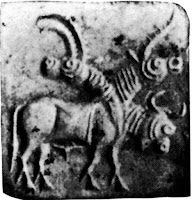
 Banawali
Banawali Dholavira seal
Dholavira seal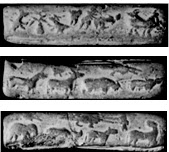 m0489a,b,c Mohenjo-daro prism tablet. r-an:ku, ran:ku = fornication, adultery (Telugu); rebus: ranku ‘tin’ (Santali) PLUS other hieroglyphs also read rebus in Meluhha (mleccha) as mlecchita vikalpa.
m0489a,b,c Mohenjo-daro prism tablet. r-an:ku, ran:ku = fornication, adultery (Telugu); rebus: ranku ‘tin’ (Santali) PLUS other hieroglyphs also read rebus in Meluhha (mleccha) as mlecchita vikalpa.  Rati on a composite horse.
Rati on a composite horse.



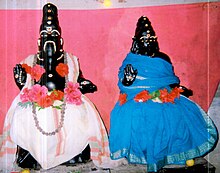 Agastya and Lopāmudrā
Agastya and Lopāmudrā "Odin wins for men the magic mead" by Willy Pogany. The
"Odin wins for men the magic mead" by Willy Pogany. The 

 Mohenjo-daro silver seal. m1199 Mackay 1938, vol. 2, Pl. XC,1; XCVI, 520 karaNika 'rim of jar' rebus: karaNika 'helmsman, supercargo' karã̄ n. pl. wristlets, bangles (Gujarati) rebus: khAr 'blacksmith' ayo 'fish' rebus: ayas 'alloy metal' khambhaṛā 'fish-fin' rebus: kammaTa 'mint, coiner, coinage'.
Mohenjo-daro silver seal. m1199 Mackay 1938, vol. 2, Pl. XC,1; XCVI, 520 karaNika 'rim of jar' rebus: karaNika 'helmsman, supercargo' karã̄ n. pl. wristlets, bangles (Gujarati) rebus: khAr 'blacksmith' ayo 'fish' rebus: ayas 'alloy metal' khambhaṛā 'fish-fin' rebus: kammaTa 'mint, coiner, coinage'. Altyn-depe. Silver seal. Pictograph of ligatured animal with three heads. Hieroglyph: sangaDa 'joined animals' (Marathi) Rebus:
Altyn-depe. Silver seal. Pictograph of ligatured animal with three heads. Hieroglyph: sangaDa 'joined animals' (Marathi) Rebus:  Mohenjo-daro. Copper seala. National Museum, New Delhi (Source: Page 18, Fig. 8A in: Deo Prakash Sharma, 2000, Harappan seals, sealings and copper tablets, Delhi, National Museum).
Mohenjo-daro. Copper seala. National Museum, New Delhi (Source: Page 18, Fig. 8A in: Deo Prakash Sharma, 2000, Harappan seals, sealings and copper tablets, Delhi, National Museum).



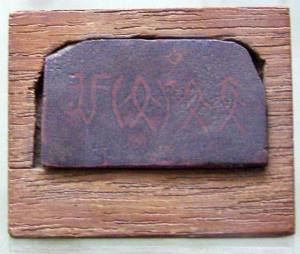 Bronze plate with inscription. Sarasvati-Sindhu civilization Lahore Museum. (This is referred to as Copper plate on Indus Script Corpora).On the obverse of this copper plate inscrition is a hierolyph-multiplex: rhinoceros PLUS trough:
Bronze plate with inscription. Sarasvati-Sindhu civilization Lahore Museum. (This is referred to as Copper plate on Indus Script Corpora).On the obverse of this copper plate inscrition is a hierolyph-multiplex: rhinoceros PLUS trough:


 Important find-spots in India of metal objects
Important find-spots in India of metal objects




 Susa pot with metal implements and Sarasvati Script inscription. ayo 'fish' rebus: ayas 'alloy metal' PLUS karaDa 'aquatic bird' rebus: karaDa 'hard alloy'.kANDa 'water' rebus: khaNDa 'implements' PLUS dAma 'tied rope' rebus: dhAu 'mineral red ore' (Rigveda).
Susa pot with metal implements and Sarasvati Script inscription. ayo 'fish' rebus: ayas 'alloy metal' PLUS karaDa 'aquatic bird' rebus: karaDa 'hard alloy'.kANDa 'water' rebus: khaNDa 'implements' PLUS dAma 'tied rope' rebus: dhAu 'mineral red ore' (Rigveda).



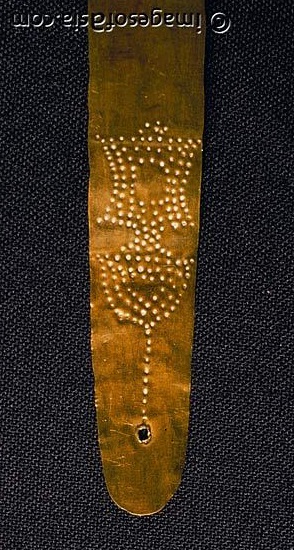


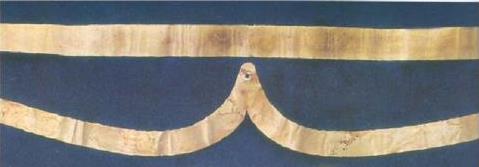

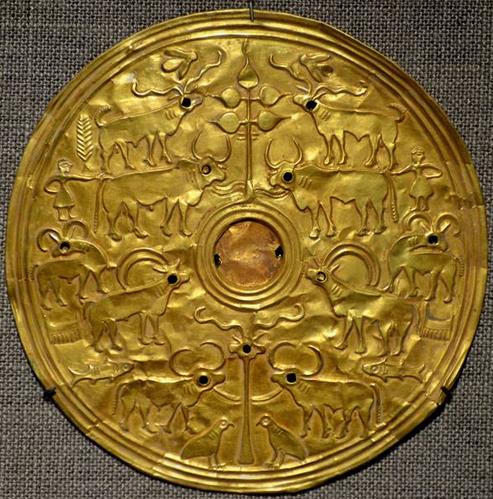 Kuwait Gold Disk with Sarasvati Script hieroglyphs/hypertexts..Kuwait National Museum. See decipherment at
Kuwait Gold Disk with Sarasvati Script hieroglyphs/hypertexts..Kuwait National Museum. See decipherment at  Focus on the center-piece: brazier PLUS eye PLUS eyelid PLUS horns of markhor:
Focus on the center-piece: brazier PLUS eye PLUS eyelid PLUS horns of markhor: 



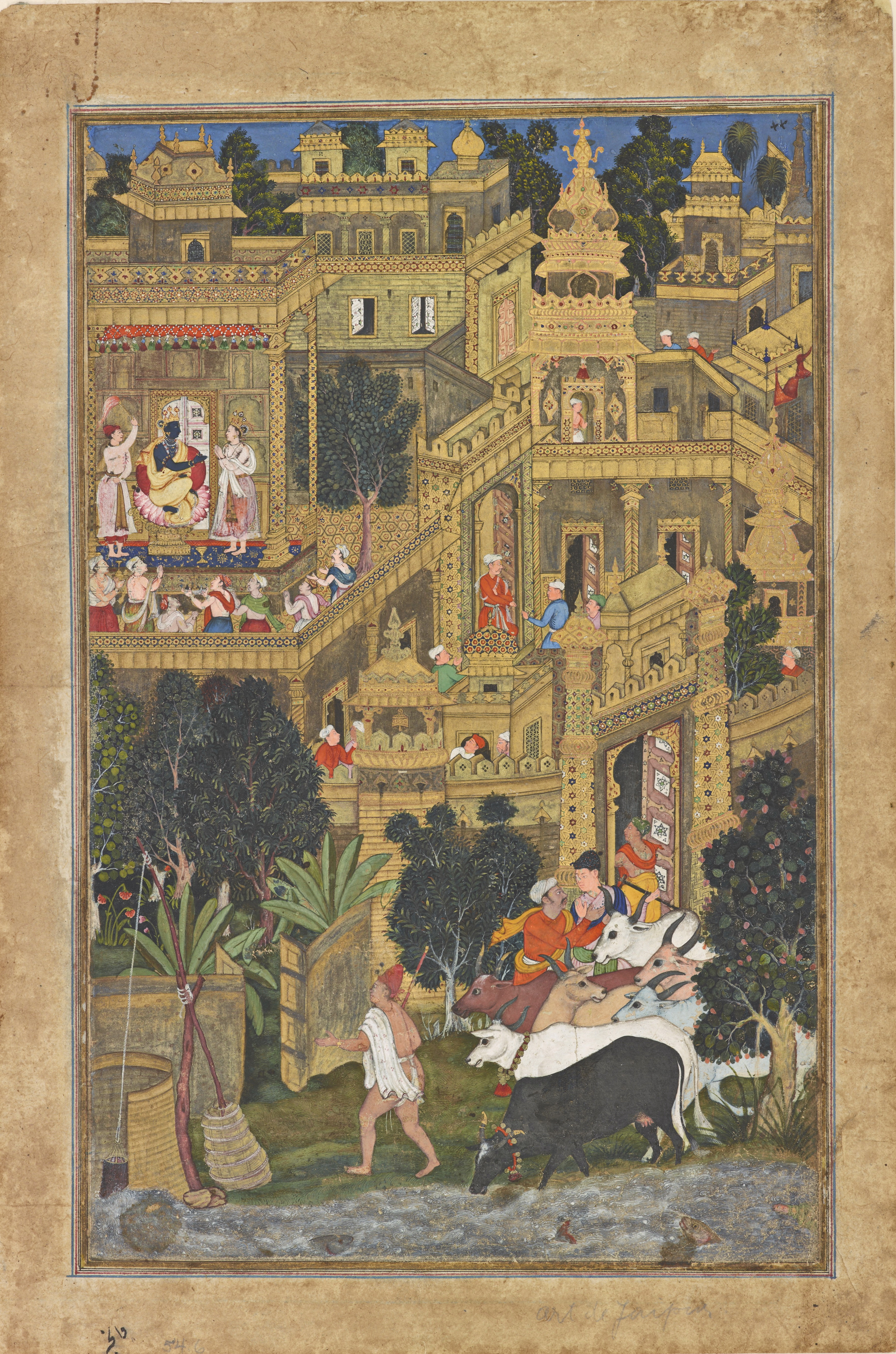





































































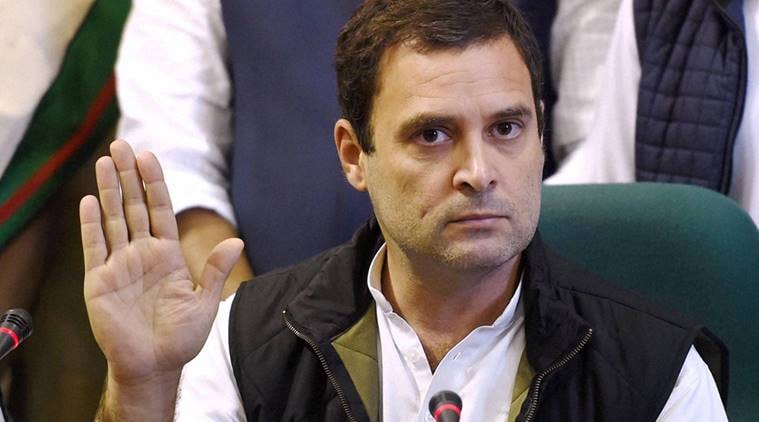



 Asaduddin Owaisi observed that days of the dynastic politics are certainly over now.(PTI Photo)
Asaduddin Owaisi observed that days of the dynastic politics are certainly over now.(PTI Photo)





